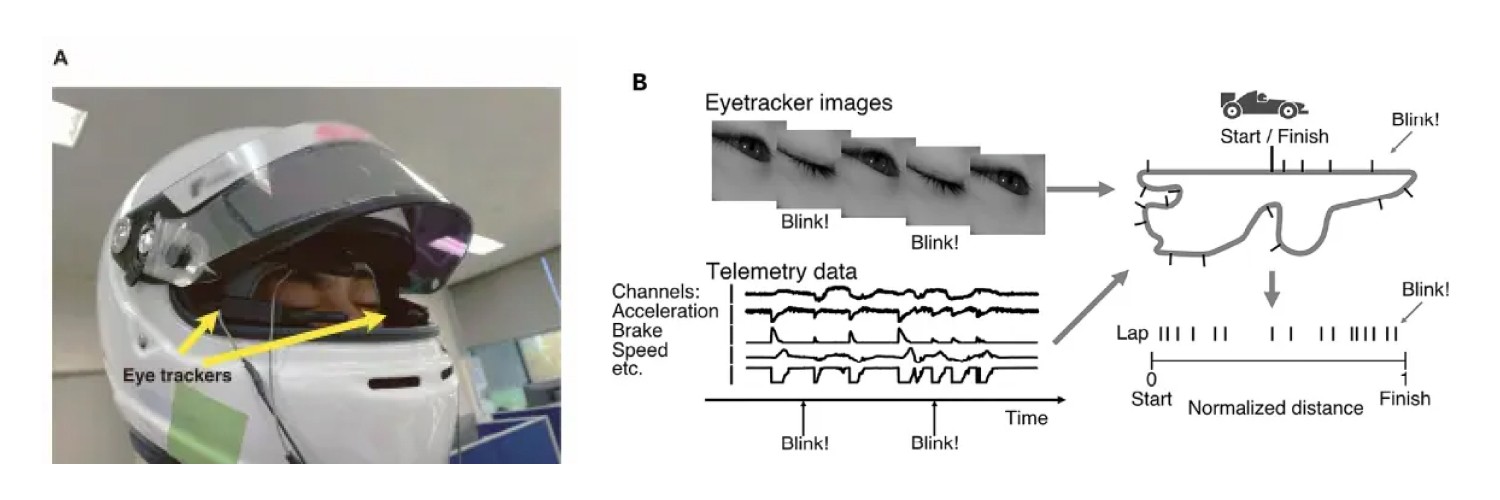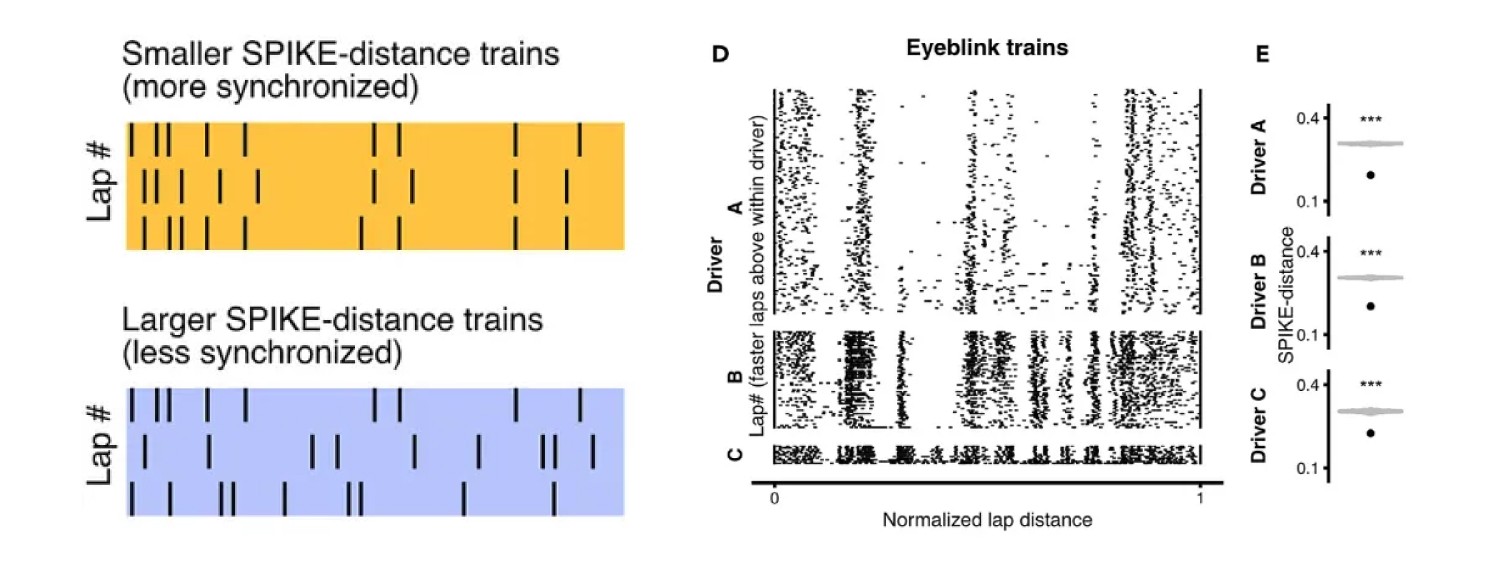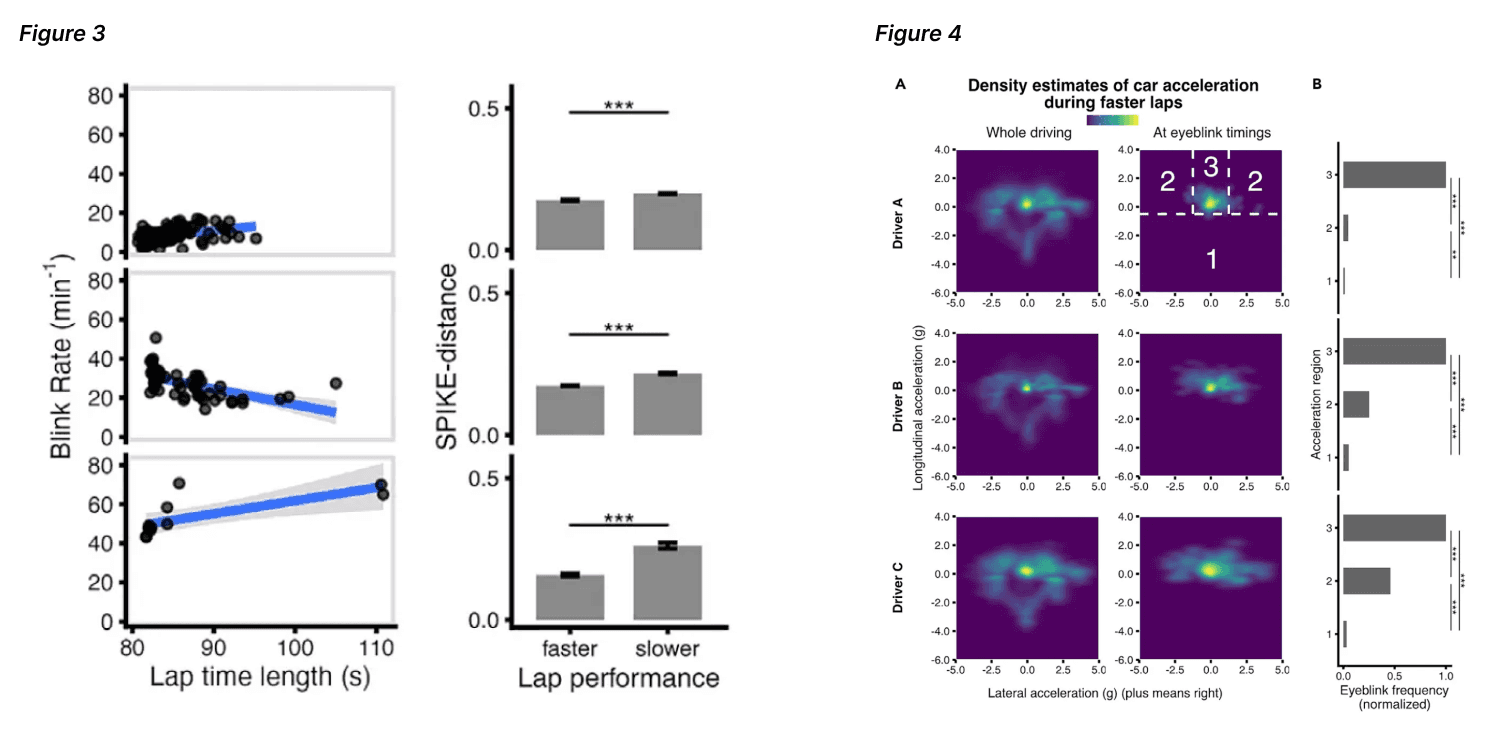Reproducible blink patterns in Formula car driving
Research Digest
Author(s): Neil M. Thomas, Nadia Paraskevoudi
October 26, 2023

Photo by Jesper Giortz-Behrens on Unsplash
How does eyeblink behaviour affect real-world driving performance?
Formula racing represents the peak of high-speed motorsport, where drivers steer state-of-the-art, open-wheel racing cars in competitions that demand extraordinary precision, skill, and fast decision-making. In the fast-paced world of Formula racing, cars often zip around tracks at speeds exceeding 200 miles per hour, navigating sharp turns and challenging straights. In such environments, the importance of quick decisions cannot be emphasised enough. Hence, it is crucial to understand the factors influencing drivers’ decision-making and reaction times to optimise racing performance.
On average, we blink approximately 20 times per minute, and each blink can result in a loss of approximately 200 ms of visual information. Suboptimal eyeblink timing could therefore have a significant impact on racing performance.
However, while previous research has examined the relationship between eyeblink behaviour and cognitive states during simulated driving, studies on eyeblink behaviour during real-world driving scenarios remain limited.
Examining eyeblink behaviour in real-world Formula car driving
In a recent study published in iScience, Nishizono and colleagues tested for possible links between eyeblink behaviour and car control in the context of Formula car driving. Their study focused on analyzing the eyeblink patterns of three highly skilled racing drivers during real-world practice sessions.
Their goal was to assess the eyeblink patterns across each lap of a given driver and course combination, as well as during different phases of the driving such as cornering or overtaking. Eyeblink behaviour that is shown to be repeatable in certain phases of a race would provide evidence for specific eyeblink strategies adopted by the drivers.
To accomplish this, they used the Pupil Core head-mounted eye tracking system along with a comprehensive data acquisition setup that captured various parameters related to the car's performance, including speed and acceleration (Figure 1). With this setup, they were not only able to pinpoint eyeblink patterns throughout the lap progression but also to investigate the potential connection between these patterns and driving performance.

Figure 1. A) The eye-tracking cameras were installed inside the helmet. B) Video images from Pupil Core and car telemetry data were used to calculate the eyeblink distance from the start/finish line which was then normalised to the maximum travelled distance in the lap.
To quantify eyeblink patterns, the researchers utilized SPIKE-distance. This is a statistical metric that was initially designed to assess the timing differences between spikes in multiple firing neurons, but can be used for other event sequences, e.g. blinks. It compares the similarity or dissimilarity between two or more spike trains. In this context, spike trains refer to sequences of eyeblink trains. The SPIKE-distance reduces as event sequences become more synchronized (as illustrated in Figure 2, left).
How did the authors use this metric?
The authors first calculated the SPIKE-distance values for each driver and course combination and tested them against a null distribution of permutations. This allowed them to determine whether the observed SPIKE-distance values were statistically significant and not due to chance. Ultimately, this testing aimed to investigate the hypothesis that eyeblinks might serve as indicators of reproducible behavioural patterns during Formula driving.
Reproducible eyeblink patterns
The researchers found that the eyeblink patterns of the three formula car drivers were highly reproducible across multiple laps and races. In other words, the drivers each exhibited consistent eyeblink behaviour patterns during each drive (see Figure 2, right).

Figure 2. Left: Smaller vs. larger SPIKE distance trains reflect more vs. less synchronised event trains. Right: Blink patterns are highly reproducible among drives across multiple laps.
Eyeblink generation probability relates to driving performance
The researchers also identified key factors intertwined with the drivers' eyeblink patterns and their impact on lap performance and acceleration. They found that the moment-by-moment eyeblink generation probability was influenced by the lap pace, such that faster lap times correlated with more synchronised and pronounced blink patterns (Figure 3). This suggests that driving performance is very much linked to eyeblink behaviour.
Additionally, the moment-by-moment eyeblink generation probability was influenced by the regions of car acceleration. The frequency of eyeblinks significantly diminished during regions 1 and 2, indicating stronger blink suppression when the car was decelerating significantly or accelerating laterally (Figure 4). This finding suggests that the drivers were adapting their eyeblink patterns to the demands of the track and their driving performance, effectively suppressing blinks during critical moments requiring heightened focus (e.g., phases associated with the beginning of the race, during cornering, overtaking, and battling with other racers).

Figure 3 - Eyeblink rate and lap time length correlate (left) and blink trains are more synchronised during faster than slower laps (right). Figure 4 - Eyeblink suppression related to car acceleration.
Implications for driving performance and safety
By combining eye tracking with car telemetry data, Nishizono and colleagues show eyeblink suppression during key phases of racing that coincide with very important manoeuvres. Secondly, these patterns were directly linked to racing performance, with more synchronized blink patterns during laps that were completed faster.
These findings suggest that training programs that improve eyeblink control and cognitive states may enhance high-level driving performance and safety, and also open up possibilities for developing real-time monitoring systems that detect driver fatigue or distraction in race car drivers.
Key highlights
Eyeblink patterns during formula driving were highly reproducible across multiple laps and races.
Faster lap times correlated with more synchronised and pronounced blink patterns.
Blinks were suppressed during critical moments requiring heightened focus, that is when the car was accelerating laterally (e.g., battling with other racers).
You can read the full article here: https://www.cell.com/iscience/fulltext/S2589-0042(23)00880-5
If you wish to include your published work or research projects in future Research Digests, please reach out!